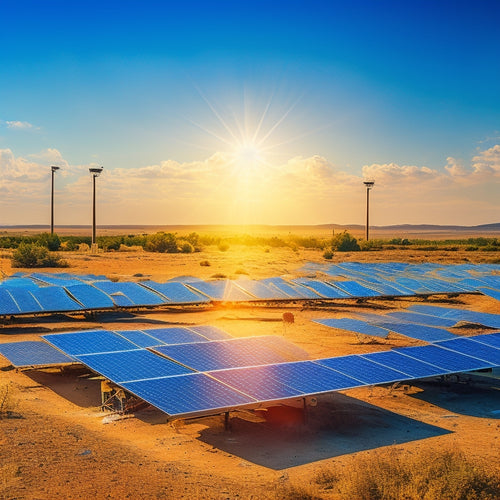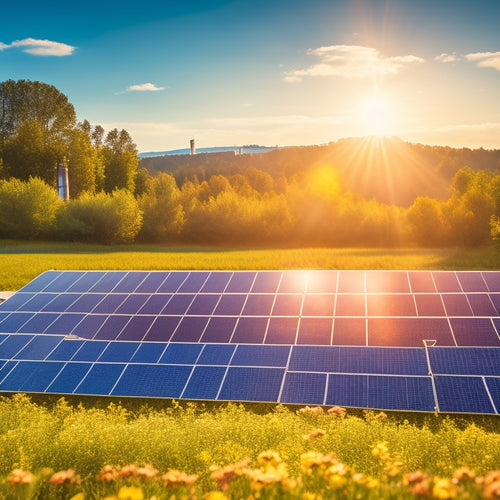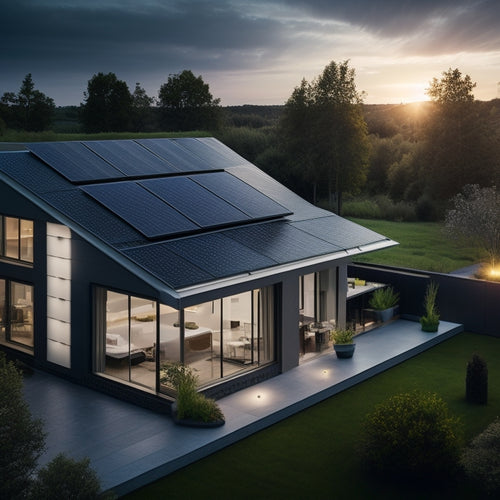
Install Solar Power at Home
Share
By installing solar power at home, you're taking the first step towards energy independence, reducing your reliance on the grid and lowering your utility bills. With a system customized to your energy needs, you can save up to $1000 annually and minimize your carbon footprint. Monocrystalline silicon cells offer high power output and efficiency, converting more sunlight into electricity. A thorough roof assessment is essential to identify obstructions and optimize panel performance. By understanding your energy needs, system size, and roof conditions, you'll be on your way to utilizing the full potential of solar power - and there's more to investigate to maximize your energy gains.
The Essentials
- Assess your energy needs to determine the optimal solar power system size for your home, ensuring energy independence and reduced utility bills.
- Installing solar power can lead to significant annual savings, up to $1000, and improve financial stability by reducing energy expenses.
- Solar power systems minimize environmental impact by reducing reliance on fossil fuels, leading to lower greenhouse gas emissions and a smaller carbon footprint.
- High-efficiency solar panels, typically above 18% efficiency, convert more sunlight into electricity, resulting in increased energy generation and optimal performance.
- A thorough roof assessment is crucial to identify obstructions, determine optimal installation techniques, and maximize energy output from your solar panels.
Zero Energy Dependency
By installing solar power at home, you're working towards energy self-sufficiency goals, reducing your reliance on the grid and creating a more sustainable future.
With the help of renewable energy solutions, you can break free from the constraints of traditional grid-based energy and utilize the power of the sun for your home.
As you investigate this option, you'll uncover the benefits of generating your own clean energy and enjoying the long-term savings that come with it.
With a zero-energy dependency system, you'll greatly reduce your carbon footprint, minimizing the impact on the environment.
Energy Self-Sufficiency Goals
Frequently, homeowners who invest in solar power systems aim to achieve energy self-sufficiency, a state where their property generates as much energy as it consumes. This goal is often driven by a desire for energy independence and sustainable living. By producing your own energy, you're no longer reliant on the grid and can greatly reduce your utility bills.
To achieve energy self-sufficiency, you'll need to assess your energy needs and determine the size of the solar power system required to meet those needs. Consider the following factors:
| Energy Needs | System Size | Energy Independence |
|---|---|---|
| Low (small home, efficient appliances) | Small (2-3 kW) | 80-90% |
| Medium (average home, standard appliances) | Medium (5-6 kW) | 50-70% |
| High (large home, many appliances) | Large (10-12 kW) | 30-50% |
Reduced Carbon Footprint
As you strive for energy self-sufficiency, you're likely motivated by a desire to minimize your environmental impact. One of the most notable benefits of installing solar power at home is the reduced carbon footprint it affords. By utilizing renewable energy from the sun, you're no longer reliant on fossil fuels, which are a major contributor to greenhouse gas emissions.
Additionally, with a home energy system, you can overcome the unpredictable nature of power outages and enjoy energy independence, allowing you to have a reliable source of energy. This is especially important when considering the long-term benefits of sustainable living.
With solar power, you can greatly decrease your carbon footprint, aligning with the principles of sustainable living. According to the National Renewable Energy Laboratory, a typical residential solar panel system can reduce carbon emissions by 3-4 tons per year. This is equivalent to planting over 100 trees annually.
Saves You $1000
By installing solar power at home, you'll lower your bills and cut energy costs, resulting in significant annual savings.
With a solar roof installation, you'll not only reduce your energy expenses but also contribute to a cleaner environment by utilizing renewable energy solutions renewable energy credits.
On average, homeowners who switch to solar energy can save up to $1000 per year.
This substantial reduction in your energy expenses will add up to make a big impact on your budget over time.
Lower Your Bills
You can considerably reduce your energy expenses by installing solar power at home, which translates to saving around $1000 per year. This significant reduction in your utility bills will give you the financial freedom you've been longing for.
| Before Solar | After Solar |
|---|---|
| High energy bills | Lower energy bills |
| dependence on grid | Energy independence |
| Limited savings | $1000 annual savings |
| Unstable energy prices | Stable energy prices |
| No energy savings | 15-20% energy savings |
Cut Energy Costs
Reducing your energy expenses is a notable advantage of installing solar power at home, and it's an area where you can save a substantial amount of money. By utilizing the power of the sun, you can cut your energy costs considerably, which translates to more money in your pocket.
With solar power, you can save up to $1000 per year on your energy bills, depending on your energy usage and the size of your solar panel system.
To maximize your energy savings, it's crucial to assess your current energy usage and identify areas where you can optimize your energy consumption. This involves reviewing your past energy bills, identifying energy-intensive appliances, and making adjustments to your daily habits.
By doing so, you can create a budget plan that aligns with your energy savings goals. With solar power, you can enjoy greater control over your energy expenses, making it easier to manage your budget and achieve financial freedom.
Monocrystalline Silicon Cell Efficiency
When you're selecting monocrystalline silicon cells for your solar power system, you'll want to evaluate the cell efficiency factors that impact their performance.
These factors, such as temperature and irradiance, can affect the cells' ability to convert sunlight into electricity.
With high power output being a key benefit, monocrystalline silicon cells are a popular choice for homeowners looking to maximize their energy generation, especially when it comes to residential solar panels that require efficient PV modules and solar inverters.
Cell Efficiency Factors
An essential aspect of solar panel performance is cell efficiency, which greatly impacts the overall energy output of a solar power system. As you consider installing solar power at home, understanding cell efficiency factors is vital to maximizing your energy output.
Monocrystalline silicon cells, in particular, have higher efficiencies due to their crystal structure. However, other factors can influence cell performance, including installation techniques, temperature, and reflectance.
| Cell Efficiency Factor | Impact on Cell Performance |
|---|---|
| Installation angle and orientation | Affects the amount of sunlight cells receive, impacting energy output |
| Temperature | Higher temperatures reduce cell efficiency, while lower temperatures improve it |
| Reflectance and shading | Shading and reflection can reduce energy output by blocking sunlight |
High Power Output
By virtue of their superior crystal structure, monocrystalline silicon cells boast higher power output compared to other types of solar cells. This means you can generate more electricity from the same surface area, making them an attractive option for those looking to maximize their energy independence.
With monocrystalline silicon cells, you can expect higher wattage ratings and improved efficiency rates. For instance, a typical monocrystalline solar panel can produce up to 400 watts of power, whereas polycrystalline or thin-film panels might only reach 250-300 watts.
This increased power output translates to more electricity generated per hour of sunlight, which can then be stored in energy storage solutions like batteries or fed back into the grid.
Recent solar technology advancements have further enhanced the performance of monocrystalline silicon cells. You can now find high-efficiency panels with ratings above 22%, considerably higher than the industry average.
Assess Your Roof's Shading
You'll want to identify any roof obstructions that could cast shade on your solar panels, such as skylights, vents, and chimneys.
For a seamless installation process, consider consulting with professional contractors or electricians who specialize in solar panel installation.
Next, analyze the shading pattern on your roof, considering the time of day and year, as well as surrounding trees or buildings.
Roof Obstructions to Consider
As your solar panel system's energy output depends heavily on the amount of sunlight it receives, it's vital to assess your roof's shading and identify potential obstructions.
You'll need to take into account the roof angle, as a steeply pitched roof may require specialized installation techniques to guarantee peak energy harvesting. Skylights, vents, and chimneys can also cast shadows, reducing energy output.
Additionally, nearby trees, neighboring buildings, or even your own home's design features can obstruct sunlight.
When evaluating your roof, take note of the direction it faces and the time of day when it receives the most sunlight. This information will help you determine the best placement for your solar panels.
Think about the size and shape of your roof, as well as any existing obstructions, to maximize energy production.
Shading Pattern Analysis
Evaluating your roof's shading patterns is an essential step in maximizing your solar panel system's energy output.
You'll need to assess the shading effects on your roof to guarantee your solar panels receive maximum sunlight. Start by analyzing the sun's path across your roof throughout the day, taking note of any obstructions that cast shadows. This sunlight analysis will help you identify areas where shading is most prevalent.
Use a shading analysis tool or consult with a solar professional to determine the impact of shading on your energy output.
They'll assess the shading patterns and provide recommendations for ideal panel placement. Consider factors like tree coverage, nearby buildings, and roof features like vents, skylights, or chimneys that may cast shadows.
Higher Energy Conversion Rate
When you're selecting solar panels, you'll want to look for higher efficiency cells that can convert a larger percentage of sunlight into electricity.
These cells typically have a higher energy conversion rate, which means you'll generate more power per hour of sunlight.
Higher Efficiency Cells
Higher efficiency cells are designed to maximize your solar power system's energy conversion rate, allowing you to generate more electricity from the same amount of sunlight. This means you'll get more bang for your buck, literally utilizing the power of the sun to fuel your home.
Solar cell advancements have led to significant efficiency innovations, and you can benefit from these breakthroughs. Take a look at the comparison below to see how higher efficiency cells can impact your energy output:
| Efficiency Rating | Energy Output (kWh) |
|---|---|
| 15% | 300 kWh/month |
| 18% | 360 kWh/month |
| 20% | 420 kWh/month |
As you can see, a higher efficiency rating translates to more energy produced from the same amount of sunlight. This means you'll be able to power more appliances, reduce your reliance on the grid, and enjoy greater energy independence. By choosing higher efficiency cells, you're investing in a more efficient and effective solar power system that will serve you well for years to come.
Frequently Asked Questions
Can I Install Solar Panels on a Rented Property?
You can consider solar panels on a rented property, but you'll need your landlord's permission. Research renter rights in your state and investigate solar leases, which let you benefit from solar energy without owning the panels.
How Long Does a Typical Solar Panel Installation Take?
You'll typically wait 2-5 months for a solar panel installation, but the timeline varies depending on installation factors like system size, roof complexity, and local permits, so plan ahead to utilize the freedom of renewable energy.
Are Solar Panels Resistant to Extreme Weather Conditions?
You'll be pleased to know that solar panels are designed to withstand extreme weather conditions, boasting durability and resilience that guarantees they'll keep generating power even in harsh environments, from scorching heat to freezing cold and intense storms.
Can I Sell Excess Energy Back to the Grid?
You'll benefit from net metering benefits, earning credits for excess energy produced, and can sell it back through energy buyback programs, giving you control and flexibility in managing your power usage and even generating revenue.
Do Solar Panels Require Regular Maintenance?
You'll need to perform occasional solar panel cleaning to guarantee peak system performance, as dirt and debris can reduce energy output; regular inspections can also help identify potential issues before they impact your energy independence.
Final Thoughts
As you flip the switch, imagine the utility company's meter spinning backwards, weeping tears of defeat as you siphon energy from the sun. Your roof, once a mere protector from the elements, now a powerhouse of independence. You're no longer beholden to their whims, freed from the shackles of energy dependence. The sweet taste of savings - $1000, to be exact - dances in your wallet. Ah, the joys of installing solar power at home, where the only energy crisis is deciding how to spend your newfound wealth.
Related Posts
-

What Happens Without a Charge Controller in Solar Panels
Without a charge controller in your solar panel system, you risk overheating batteries due to overcharging, which can...
-

Advantages of Solar Generating Systems Over Traditional Energy
Solar generating systems provide several key advantages over traditional energy sources. You'll experience lower long...
-

Home Solar Battery
You're opting for a home solar battery that allows you to utilize the power of the sun during the day and use it at n...


